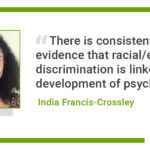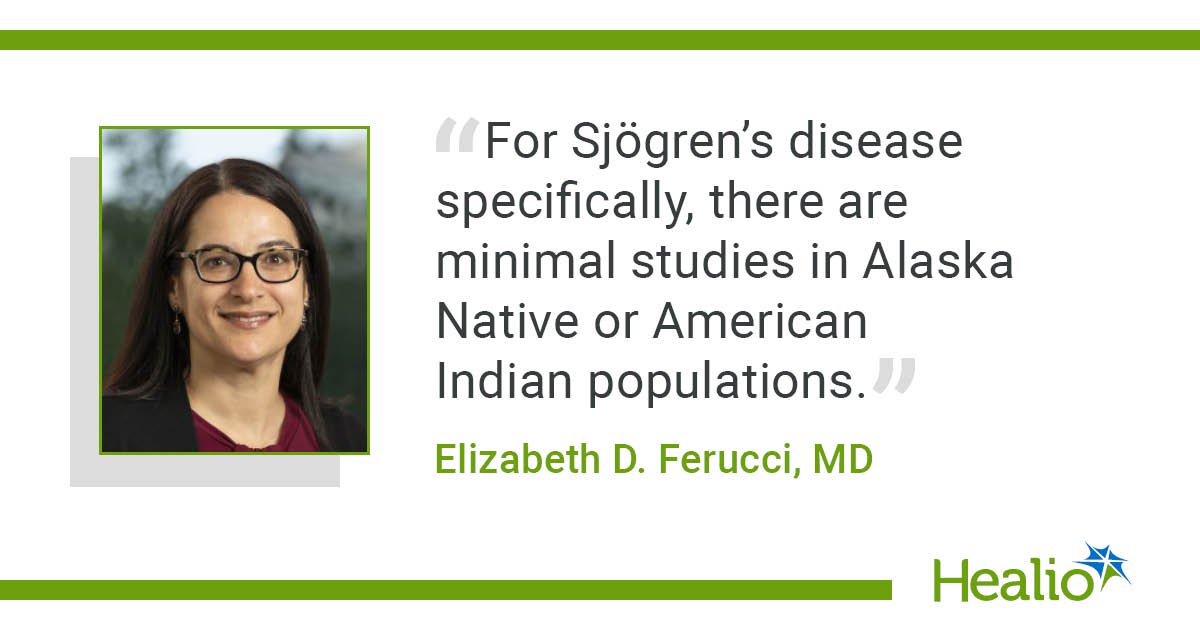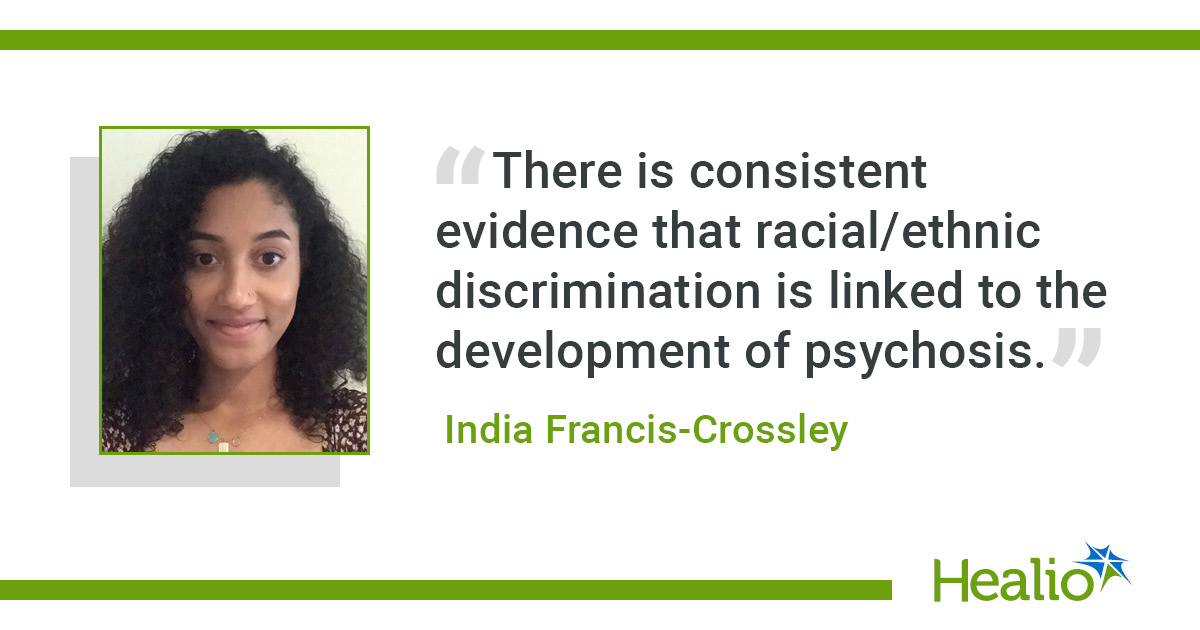October 10, 2025
4 min read
Key takeaways:
- Alaska Native populations had higher rates of Sjögren’s disease than the general population.
- RA and lupus were commonly associated with Sjögren’s in these patients.
Sjögren’s disease incidence is greater in Alaska Native and American Indian populations in Alaska than in the general population, according to findings published in Arthritis Care & Research.
“Rheumatologists should be aware of the epidemiology of different rheumatic diseases in the Alaska Native/American Indian population,” Elizabeth D. Ferucci, MD, MPH, FACP, from Community Health Services at the Alaska Native Tribal Health Consortium, told Healio. “This study documented higher rates of Sjögren’s disease than in other populations and complements prior work showing higher rates of rheumatoid arthritis and systemic lupus erythematosus as well.”

To determine the prevalence, incidence and clinical characteristics of Sjögren’s disease among Alaska Native and American Indian populations in Alaska, Ferucci and colleagues assessed data from the Alaska Tribal Health System (ATHS) between 2012 and 2019, which they compared with data from the U.S. general population. According to the researchers, the ATHS is a “statewide network of tribal health organizations operating self-governed health programs under a compact agreement with the United States Indian Health Service.”
The researchers defined Sjögren’s disease based on positive Ro/SSA antigen with sicca symptoms, the 2016 American College of Rheumatology/EULAR criteria and the 2012 ACR criteria. Results were reported as age-adjusted prevalence of Sjögren’s disease per 100,000 adults.
According to the researchers, Alaska Native and American Indian populations demonstrated an age-adjusted Sjögren’s disease prevalence of 199 per 100,000 adults (95% CI, 170-231). The primary Sjögren’s disease incidence rate was 129 per 100,000 (95% CI, 106-155), while the secondary incident rate was 70 per 100,000 (95% CI, 54-91). The researchers observed an age-adjusted incidence rate of 16.6 per 100,000 person-years (95% CI, 13.7-20).
Further analysis indicated that, among the 177 adults diagnosed with Sjögren’s disease by a rheumatologist, 66% met modified criteria, while only 5% underwent a salivary gland biopsy and 3% met 2016 ACR/EULAR or 2012 ACR criteria.
RA and SLE were the most common associated conditions in secondary Sjögren’s disease.
In their conclusion, the researchers compared these figures to a recent 2024 review that estimated a prevalence of 10 to 100 per 100,000 adults for primary Sjögren’s disease, “based on best evidence.” However, they acknowledged that their methodology and adjustments differed from that of the review.
Healio sat down with Ferucci to discuss the importance of studying Sjögren’s disease in Alaska Native and American Indian populations, and what these data mean for rheumatologists.
Healio: Why did you decide to study Sjögren’s disease in Alaska Native and American Indian populations? What was the rationale behind the study?
Ferucci: This Sjögren’s disease research is part of a larger NIH-funded study called the “Arthritis and Autoimmune Disease Epidemiology and Impact in the Alaska Native Population.” The overall study was designed to determine the prevalence of different forms of arthritis and autoimmune diseases, as well as assess hospitalizations and joint replacements in people with arthritis.
Additionally, the study serves as a building block to reach parity in the amount of research conducted on the prevalence and impact of arthritis and autoimmune diseases in Alaska Native populations as compared to non-Indigenous populations. For Sjögren’s disease specifically, there are minimal studies in Alaska Native or American Indian populations.
Healio: Could you talk about the participating organizations in the Alaska Tribal Health System? Is this the main data set from which to conduct research in the area?
Ferucci: We collected data using queries of the electronic health records of Tribal health organizations within the Alaska Tribal Health System, with most of the organizations agreeing to participate and share data for the study.
There is no data set readily available for research in the area. Data were pulled from electronic health records of different organizations and pooled for this study with appropriate tribal and Alaska Area Institutional Review Board approvals.
Healio: Your results show high rates of Sjögren’s disease in this population compared with other populations. Could you discuss possible reasons why?
Ferucci: This research only determined the prevalence and does not address underlying causes. The prevalence of some other rheumatic diseases is higher in this population (such as RA and SLE), and the underlying risk and protective factors are likely multifactorial.
We hope to investigate these factors further in future work.
Healio: Is there any possibility that the results were skewed in some way, or for some reason? Misdiagnosis, issues with diagnostic criteria?
Ferucci: This study relied on data from the health record. We were only able to identify people who had a provider diagnosis stated and could not identify undiagnosed individuals. In addition, all data measuring respective criteria being met or not met were derived from the health record used for clinical care, rather than research purposes. Therefore, it is possible that criteria are present but not documented, and recommended tests in the classification criteria might not be performed in clinical practice.
A recent study by Izmirly and colleagues in Manhattan noted similar limitations on clinical criteria data.
Finally, we limited our study to Alaska Native or American Indian people accessing care in the Alaska Tribal Health System, which would not include Alaska Native and American Indian individuals who are not patients of this system. However, we also used the Alaska Tribal Health System population as the denominator for this study.
Healio: What were the limitations of your study?
Ferucci: As discussed above, information about diagnosis and classification criteria was limited to what was documented in the health record. We were not able to interact with individuals to capture patient-reported outcomes or additional information about their Sjögren’s disease.
For more information:
Elizabeth D. Ferucci, MD, can be reached at EDFerucci@anthc.org.








